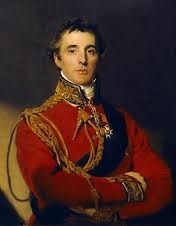Kristine Hughes's Blog, page 127
May 3, 2012
from The Naturalists' Diary, May 1826
The Naturalists’ Diary, May 1826
From The Time’s Telescope

There is something revivifying in this season of the year—a gaiety and mirthfulness of which all God’s creatures more or less partake. A thousand joyous feelings are associated with the smell of hawthorn, and the sight of the bright green trees, and the sound of the notes of the sweet singing birds; and the daisies and cowslips spangle the surface of the grassy fields, and the playful butterflies wanton in the glittering sunbeams.
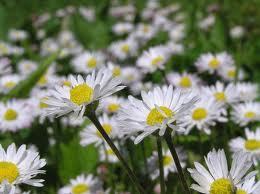 Daisies
Daisies
To wander at will, in the earliest hours of spring (as it is beautifully observed by Mr. Wiffen, in his Preface to the ‘Aonian Hours’) is one of the sweetest and most refined enjoyments. The face of things and the mind’s feelings have then a fresher aspect and a dearer sensation than at any other period of the year.
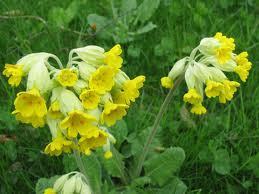 Cowslips
Cowslips
It is only at the first starting of Nature from the repose of winter, that these emotions are forcibly excited; for, after we have been accustomed but for a few weeks to the prospect of buds, and flowers, and the gladness of all things, the mind recedes into its habitual temper and tone of feeling. When these sensations are connected with other associations,--with the spot of our boyhood or our birth, or with the pleasures of maturer life, the charm becomes still stronger and sweeter; and we may truly say, as the Arabian prophet exclaimed of Damascus, “This is almost too delicious!”
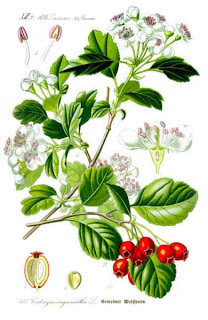 Hawthorne
Hawthorne
Let our readers, then, particularly our female friends,Rise betimes, while th’ opal-coloured morn
In golden pomp doth May-day’s door adorn
and hasten to enjoy the exhilarating pleasures of a fine May morning.
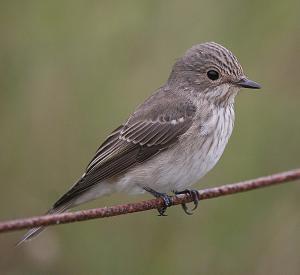 Spotted Flycatcher
Spotted Flycatcher
The latest species of the summer birds of passage arrive about the beginning of May. Among these are the goatsucker, or fern-owl, the spotted fly-catcher, and the sedge bird. In this and the following month, the dotterel is in season. Birds are still occupied in building their nests or laying their eggs. The parental care of birds at this period, in hatching and rearing their young, can never be sufficiently admired.
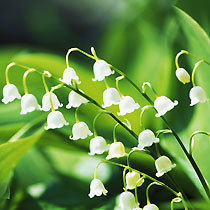
The lily of the valley now opens her snowy bells, and the flowers of the chestnut-tree begin to unfold; the tulip tree has its leaves quite out; and the flowers of the Scotch fir, the beech, the oak, and the honey-suckle, climbing round its neighbours for support, are now in full bloom.
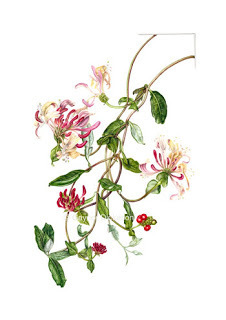 honeysuckle
honeysuckle
All the varieties of the strawberry, ‘plant of my native soil,’ open their blossoms, their runners extending on all sides. The mulberry-tree puts forth its leaves.

Strawberry
The insect tribe continue to add to their numbers. A few butterflies that have passed the inclement season in the chrysalis state, are seen on the wing early in May. And about the latter end of the month, the Papilio Machaon, or swallow-tailed butterfly, one of the most superb of the British Insects, makes its appearance. It is very local, but is abundant in the places where it is found, particularly in the fens of Huntingdon and Cambridge. The caterpillar is green, banded with black, and marked by a row of red spots; it feeds on various umbellate plants.
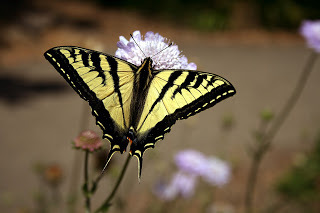
Mr. Samouelle, in his directions to the Entomological Collector says, ‘as soon as the white-thorn is in leaf, the hedges should be well beaten;--the season for taking caterpillars now commences, from which most of the Lepidoptera are obtained, and this is by far the best method, as the insects are generally perfect, and the specimens very fine. Great attention should be paid to the larvae, and they should be supplied with fresh food, and moist earth kept at the bottom of their cages.’—Introduction to British Entomology, p. 315.
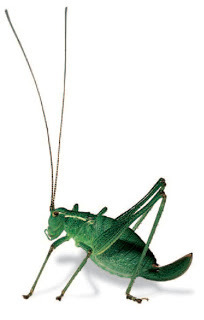
Field crickets, the chaffer or may-bug, and the forest fly, which so much annoys horses and cattle, are now seen. The female wasp appears at the latter end of the month, and the swarming of bees takes place.—The garden now affords rhubarb, green apricots, and green gooseberries, for making pies and tarts.
In this month, the orchis will be found in moist pastures, distinguished by its broad, black spotted leaves and spike of large purple flowers. The walnut has its flowers in full bloom.
The banks of rills and shaded hedges are ornamented with the pretty tribe of speedwells, particularly the germander speedwell, the field mouse-ear, the dove’s foot crane’s bill, and the read campion, the two first of azure blue, and the two last of rose colour, intermixing their flowers with attractive variety.—The country is now in perfection, every bush a nosegay, all the ground a piece of embroidery. The air, indeed, is enriched with native perfumes, and the whole creation seems to smile; on each tree we hear the voice of melody, and in every grove there is a concert of warbling music.
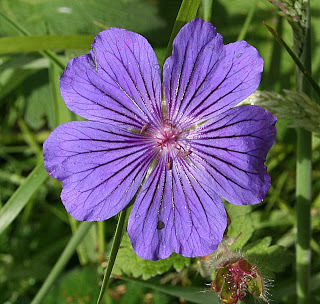 Cranesbill
Cranesbill
The lilac, the barberry, and the maple, are now in flower. At the latter end of the month rye is in ear; the mountain-ash, laburnum, the guilder-rose, clover, columbines, with their singular and fantastic nectarines,--the alder, the wild chervil, the wayfaring tree, or wild guelder-rose, and the elm, have their flowers in full bloom.
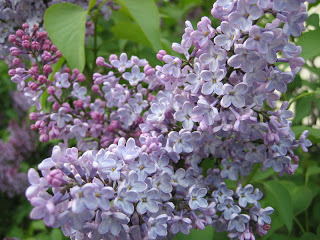 Lilac
Lilac
Many fine plants are in flower, both in artificial climates and the open garden. The American tribes flower in great numbers during this month, as Magnolias, Azaleas, Vacciniums, &c. ‘We saw in the last week of April, in Malcolm and Gray’s Nursery, Kensington, one of the finest Youlan Magnolias in flower we ever beheld. It was a standard of a conical shape, about twenty feet high, and in an open, unsheltered part of the garden. It was covered with tulip shaped blossoms of a pure white, and exceedingly fragrant. Each blossom was as large as that of a Van Thol tulip, and their perfume was sensibly felt for a circumference of many yards. Hundreds of lovers of gardening, if they were aware of the beauty of this plant, would possess a specimen, for a greater ornament no shrubbery could possess.
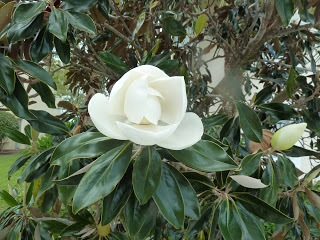 Magnolia
Magnolia
There is not a country gentleman, who, were he to see such a plant, would not have one of them, coute qui coute; but as gentlemen necessarily rely on their gardeners for selecting plants and trees, and as this tree is but of recent introduction, it is unknown to most gardeners in place. Young gardeners recently become masters and now coming out as such, will recommend it; but, still, this shows that scarcely any new plant can become general throughout the country in less than half a century from its first introduction. A gardener takes a place at twenty-five years of age, and remains in it, or in other places, thirty years probably at an average; he then dies, and is succeeded by a young man who, familiar with the best things of the preceding thirty years, introduces them. In this way, the Youlan Magnolia may be about as common as the Horse-chestnut in 1850 or 1860; Pyrus Japonica, Prunus Japonica and many now rare Azaleas and other early flowering plants, will then abound; and what a glorious sight will our shrubberies present!”—Literary Gazette.
About the middle of the month the greenhouse plants are ventured out; the rule is, the foliation of the common ash and the mulberry. This is a critical month for insects, especially the green fly or aphis family, and the caterpillars. Tobacco, lime-water, and handpicking, are the remedies.
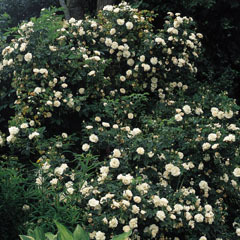 David Austin Old Roses
David Austin Old Roses
The various species of meadow grass are in flower. The buttercup spreads over the meadows; the coleseed in corn fields, bryony, the arum, or cuckoo-pint, in hedges, the Tartarian honeysuckle, and the Corchorus Japonica, now show their flowers. The ‘rose, with all its sweetest leaves yet folded,’ now tempts the changeful atmosphere of May, but, too oft oppressed with ungentle showers, and overcharged with wet, bows her head to the coming storm; reserving her riper beauties for the more powerful sun of June. Sweet violets still continue to shed their delicious odours.
Towards the end of the month, that magnificent and beautiful tree, the horse-chestnut, displays its honours of fine green leaves, and its handsome ‘spike pyramidal’ of white and red flowers; it is quite the glory of forest trees. The hawthorn (white and pink) is usually in blossom about the middle or end of the month.
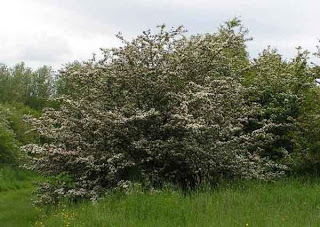 Hawthorne
Hawthorne
The principal show of tulips takes place in this month. The dazzling and gorgeous appearance of beds of tulips cannot fail to attract the notice of the most indifferent observer; some varieties of this elegant flower are very splendid, and unrivalled for the beauty of their exquisite colours. But they boast only of a showy exterior; they possess no fragrance,--and however gaudy their attire, like a handsome female devoid of mental requirements, they soon cease to call forth our admiration. ‘Surprise and wonder are transitory passions,’ and, tired of beholding mere beauty, we seek for utility in the endless charms of a cultivated mind.
Young hares or leverets, in favourable seasons are now seen feeding near the edges of woods and copses; these may be considered as the first produce of the year, but the mother will commonly bring forth two or more pairs in the season.
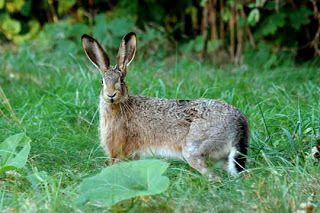 Hare
Hare
Towards the end of the month, the Phalaena humuli, called by some the ghost-moth, makes its appearance, and continues visible during the greater part of the month of June. The female glow-worm (Lampyris noctiluca) is now seen on dry banks, about woods, pastures, and hedgeways.
This is now the benting time of pigeons. After the spring-sown corn has vegetated, until the harvest, they are driven to the immature seeds and green panicles of the grasses for subsistence, and are seen in large flocks in pasture fields, where they pick up so bare a living, as to have occasioned an old couplet, often quoted in the country—
The pigeon never knoweth woeUntil a benting it doth go.
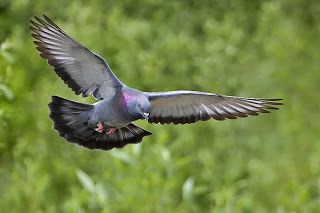 Pigeon
Pigeon
May, June, and July constitute the most fashionable portion of a ‘Winter in London’ and during this time there are more dinners, routes, concerts, and public dejeunes a la fourchette, than at any other period of the year. These eagerly sought pleasures, however, will have but little attraction for the contemplative man, and the admirer of the beauties of nature. Dinner parties at eight o’clock, and crowded assemblies which break up at two or three A.M., afford but a bad preparation for a morning ramble, to enjoy the sweet breath of May.
From The Time’s Telescope

There is something revivifying in this season of the year—a gaiety and mirthfulness of which all God’s creatures more or less partake. A thousand joyous feelings are associated with the smell of hawthorn, and the sight of the bright green trees, and the sound of the notes of the sweet singing birds; and the daisies and cowslips spangle the surface of the grassy fields, and the playful butterflies wanton in the glittering sunbeams.
 Daisies
DaisiesTo wander at will, in the earliest hours of spring (as it is beautifully observed by Mr. Wiffen, in his Preface to the ‘Aonian Hours’) is one of the sweetest and most refined enjoyments. The face of things and the mind’s feelings have then a fresher aspect and a dearer sensation than at any other period of the year.
 Cowslips
CowslipsIt is only at the first starting of Nature from the repose of winter, that these emotions are forcibly excited; for, after we have been accustomed but for a few weeks to the prospect of buds, and flowers, and the gladness of all things, the mind recedes into its habitual temper and tone of feeling. When these sensations are connected with other associations,--with the spot of our boyhood or our birth, or with the pleasures of maturer life, the charm becomes still stronger and sweeter; and we may truly say, as the Arabian prophet exclaimed of Damascus, “This is almost too delicious!”
 Hawthorne
HawthorneLet our readers, then, particularly our female friends,Rise betimes, while th’ opal-coloured morn
In golden pomp doth May-day’s door adorn
and hasten to enjoy the exhilarating pleasures of a fine May morning.
 Spotted Flycatcher
Spotted FlycatcherThe latest species of the summer birds of passage arrive about the beginning of May. Among these are the goatsucker, or fern-owl, the spotted fly-catcher, and the sedge bird. In this and the following month, the dotterel is in season. Birds are still occupied in building their nests or laying their eggs. The parental care of birds at this period, in hatching and rearing their young, can never be sufficiently admired.

The lily of the valley now opens her snowy bells, and the flowers of the chestnut-tree begin to unfold; the tulip tree has its leaves quite out; and the flowers of the Scotch fir, the beech, the oak, and the honey-suckle, climbing round its neighbours for support, are now in full bloom.
 honeysuckle
honeysuckleAll the varieties of the strawberry, ‘plant of my native soil,’ open their blossoms, their runners extending on all sides. The mulberry-tree puts forth its leaves.

Strawberry
The insect tribe continue to add to their numbers. A few butterflies that have passed the inclement season in the chrysalis state, are seen on the wing early in May. And about the latter end of the month, the Papilio Machaon, or swallow-tailed butterfly, one of the most superb of the British Insects, makes its appearance. It is very local, but is abundant in the places where it is found, particularly in the fens of Huntingdon and Cambridge. The caterpillar is green, banded with black, and marked by a row of red spots; it feeds on various umbellate plants.

Mr. Samouelle, in his directions to the Entomological Collector says, ‘as soon as the white-thorn is in leaf, the hedges should be well beaten;--the season for taking caterpillars now commences, from which most of the Lepidoptera are obtained, and this is by far the best method, as the insects are generally perfect, and the specimens very fine. Great attention should be paid to the larvae, and they should be supplied with fresh food, and moist earth kept at the bottom of their cages.’—Introduction to British Entomology, p. 315.

Field crickets, the chaffer or may-bug, and the forest fly, which so much annoys horses and cattle, are now seen. The female wasp appears at the latter end of the month, and the swarming of bees takes place.—The garden now affords rhubarb, green apricots, and green gooseberries, for making pies and tarts.
In this month, the orchis will be found in moist pastures, distinguished by its broad, black spotted leaves and spike of large purple flowers. The walnut has its flowers in full bloom.
The banks of rills and shaded hedges are ornamented with the pretty tribe of speedwells, particularly the germander speedwell, the field mouse-ear, the dove’s foot crane’s bill, and the read campion, the two first of azure blue, and the two last of rose colour, intermixing their flowers with attractive variety.—The country is now in perfection, every bush a nosegay, all the ground a piece of embroidery. The air, indeed, is enriched with native perfumes, and the whole creation seems to smile; on each tree we hear the voice of melody, and in every grove there is a concert of warbling music.
 Cranesbill
CranesbillThe lilac, the barberry, and the maple, are now in flower. At the latter end of the month rye is in ear; the mountain-ash, laburnum, the guilder-rose, clover, columbines, with their singular and fantastic nectarines,--the alder, the wild chervil, the wayfaring tree, or wild guelder-rose, and the elm, have their flowers in full bloom.
 Lilac
LilacMany fine plants are in flower, both in artificial climates and the open garden. The American tribes flower in great numbers during this month, as Magnolias, Azaleas, Vacciniums, &c. ‘We saw in the last week of April, in Malcolm and Gray’s Nursery, Kensington, one of the finest Youlan Magnolias in flower we ever beheld. It was a standard of a conical shape, about twenty feet high, and in an open, unsheltered part of the garden. It was covered with tulip shaped blossoms of a pure white, and exceedingly fragrant. Each blossom was as large as that of a Van Thol tulip, and their perfume was sensibly felt for a circumference of many yards. Hundreds of lovers of gardening, if they were aware of the beauty of this plant, would possess a specimen, for a greater ornament no shrubbery could possess.
 Magnolia
MagnoliaThere is not a country gentleman, who, were he to see such a plant, would not have one of them, coute qui coute; but as gentlemen necessarily rely on their gardeners for selecting plants and trees, and as this tree is but of recent introduction, it is unknown to most gardeners in place. Young gardeners recently become masters and now coming out as such, will recommend it; but, still, this shows that scarcely any new plant can become general throughout the country in less than half a century from its first introduction. A gardener takes a place at twenty-five years of age, and remains in it, or in other places, thirty years probably at an average; he then dies, and is succeeded by a young man who, familiar with the best things of the preceding thirty years, introduces them. In this way, the Youlan Magnolia may be about as common as the Horse-chestnut in 1850 or 1860; Pyrus Japonica, Prunus Japonica and many now rare Azaleas and other early flowering plants, will then abound; and what a glorious sight will our shrubberies present!”—Literary Gazette.
About the middle of the month the greenhouse plants are ventured out; the rule is, the foliation of the common ash and the mulberry. This is a critical month for insects, especially the green fly or aphis family, and the caterpillars. Tobacco, lime-water, and handpicking, are the remedies.
 David Austin Old Roses
David Austin Old RosesThe various species of meadow grass are in flower. The buttercup spreads over the meadows; the coleseed in corn fields, bryony, the arum, or cuckoo-pint, in hedges, the Tartarian honeysuckle, and the Corchorus Japonica, now show their flowers. The ‘rose, with all its sweetest leaves yet folded,’ now tempts the changeful atmosphere of May, but, too oft oppressed with ungentle showers, and overcharged with wet, bows her head to the coming storm; reserving her riper beauties for the more powerful sun of June. Sweet violets still continue to shed their delicious odours.
Towards the end of the month, that magnificent and beautiful tree, the horse-chestnut, displays its honours of fine green leaves, and its handsome ‘spike pyramidal’ of white and red flowers; it is quite the glory of forest trees. The hawthorn (white and pink) is usually in blossom about the middle or end of the month.
 Hawthorne
HawthorneThe principal show of tulips takes place in this month. The dazzling and gorgeous appearance of beds of tulips cannot fail to attract the notice of the most indifferent observer; some varieties of this elegant flower are very splendid, and unrivalled for the beauty of their exquisite colours. But they boast only of a showy exterior; they possess no fragrance,--and however gaudy their attire, like a handsome female devoid of mental requirements, they soon cease to call forth our admiration. ‘Surprise and wonder are transitory passions,’ and, tired of beholding mere beauty, we seek for utility in the endless charms of a cultivated mind.
Young hares or leverets, in favourable seasons are now seen feeding near the edges of woods and copses; these may be considered as the first produce of the year, but the mother will commonly bring forth two or more pairs in the season.
 Hare
HareTowards the end of the month, the Phalaena humuli, called by some the ghost-moth, makes its appearance, and continues visible during the greater part of the month of June. The female glow-worm (Lampyris noctiluca) is now seen on dry banks, about woods, pastures, and hedgeways.
This is now the benting time of pigeons. After the spring-sown corn has vegetated, until the harvest, they are driven to the immature seeds and green panicles of the grasses for subsistence, and are seen in large flocks in pasture fields, where they pick up so bare a living, as to have occasioned an old couplet, often quoted in the country—
The pigeon never knoweth woeUntil a benting it doth go.
 Pigeon
PigeonMay, June, and July constitute the most fashionable portion of a ‘Winter in London’ and during this time there are more dinners, routes, concerts, and public dejeunes a la fourchette, than at any other period of the year. These eagerly sought pleasures, however, will have but little attraction for the contemplative man, and the admirer of the beauties of nature. Dinner parties at eight o’clock, and crowded assemblies which break up at two or three A.M., afford but a bad preparation for a morning ramble, to enjoy the sweet breath of May.
Published on May 03, 2012 01:00
May 1, 2012
The Wellington Connection: Birthdays
Published on May 01, 2012 06:31
April 30, 2012
The Milk Maid
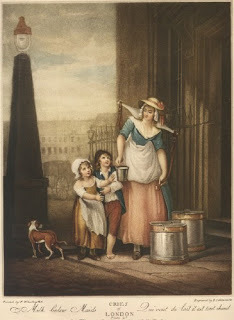
From Life in the London Streets or Struggles for Daily Bread by Richard Rowe (1881)
The following is the story of old Patty Morgan, who used to dispense glassf uls of milk in the Mall, a cheeryfaced old body, muffled in a faded Welsh plaid shawl, think of the historical associations of her place of trade.
"Oh, deary no, I've got no cows. It's my master's I take to the park, sometimes one and sometimes another, just as may happen. It's a many years I've been in London: yes, indeed, with one master and another. I used to go out with the milk for ever so long, but I'm too old for that now. I've borne the yoke in my youth, and now I get a bit of rest in my old age, not but what it's very cold sometimes sitting in the park; but what's the good of grumbling? I couldn't lug about those heavy pails now. When I was younger the saucy monkeys of boys used to make fun of me and say I waddled like a duck; so I'm thankful I've got something I can do. When I'm not milking I can knit, and it's a comfort to an old woman not to be always on her feet, and to have something to lean the back against.
"Our business varies very much. Sometimes we'll do next to nothing, and then again we'll sell about as much as the cow can give. It depends so much on the weather, you see. A fine day brings the folks out like butterflies. It's mostly children we sell to. A father will come with his little ones and treat them to a glassful each, and sometimes a nurse will be sent regular with a child that is ailin', so that it may drink new milk and smell the cow's breath. Certainly the milk is better than what's sold at the doors; yes, indeed.Oh yes, you can get pure milk from the milkmen if you want it for an invalid; they'll not cheat you, but go out of their way in a case like that, to send you the best they can,—but then, you see, you've to pay more for it. Milk was so plenty where I come from that it puzzled me at first, it did, the price they gave for it in London. Sheep's milk we used most, but we'd cow's milk as well, and as much as ever we wanted. A child wouldn't have thought much of a glass of milk there,—it wasn't any treat: I'd only to run into the dairy and help myself. . . . .
"There's often a good bit of fun and frolic about the cows, and folly too with the soldiers and the young men out with their sweethearts; but if they and the girls never drank anything worse than milk, there wouldn't be so much harm come of their courting.
"As I've told you I used to go milk-walks before I got hired to milk in the park. It's a tiring work that, carrying round the pails, and you're out in all weathers; still I always kept my health pretty well whilst I was at it. I don't drink gin, as some do, to keep the cold out: coffee in the morning and tea at night, that's what I take.
"You hear a good deal of news on a milkwalk: well, yes, no doubt a good deal of it is lies. Either the mistresses or the maids are ready enough to gossip with you. Give and take, that's their motto: hear what you've got to say, and tell you what you don't know about the neighbourhood. If some of the masters and mistresses that think everybody thinks them the respectablest of the respectable could hear what their own servants say about them, they would be rather astonished; and they wouldn't be best pleased either if they knew how these stories get about from house to house,—about the quarrels, and the lots of spirits that's drunk on the sly, and the gentleman that master doesn't like calling so often, when he's out, on missis, and all that kind of talk. No doubt a good half or more of it is made up. Folks that are so fond of talking, as most servant girls are, must tell lies pretty often, or they couldn't keep their tongues wagging as they do.
"And then it's queer the different things that are happening at the different houses you call at. At one, mayhap a new baby has just come, and the bailiffs at another; there's a wedding at No. 3, and somebody dying next door, and a hearse and mourning coaches going away from No. 7.
"Houses, too, that are pretty near as like as peas outside are so different when the door's opened, in masters, and mistresses, and servants, and children, and furniture, and cleanliness, and everything. One may be as neat as a new pin with nobody but nice people in it, and the next all muddle and muck and wrangling.
"It was my father's misfortunes sent me up to London. He had a farm out by Pont-y-pridd, and he was forced to leave it, and it broke his heart, poor old man: he died just in time to save him from the workhouse. I'd been promised to a young man who had a good place at Merthyr,—not one of the common workers, but a kind of over-looker. He wasn't true: he broke with me when our troubles came, and married my own cousin. I couldn't stand that, —to see them coming backwards and forwards to uncle's,—so I came up to London; and here I've been ever since, this many a year.
"After a bit I married a man who worked for one of my masters. He made me a fairish husband, poor man, though he never made much pretence of loving of me, and he was rather too fond of liquor. We'd a large family, and I'd to work for them; but, thank God, they were all dear, good children. None of them lived to be married, except the youngest; and now she's gone, and her little one: so I should be all alone if I couldn't say, praise God, 'Though I walk through the valley of the shadow of death, I will fear no evil; for Thou art with me; Thy rod and Thy staff they comfort me.'"
Published on April 30, 2012 23:37
Walking St. James, Part One
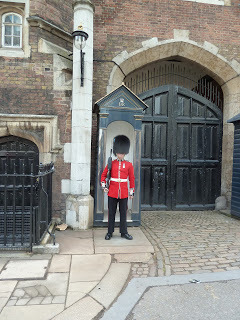 St. James Palace
St. James PalaceMy pictures of London's St. James over the years show astonishing similarity of views, but I keep trying to capture the essentials of the area and manage to fail. St. James is the area around St. James Palace and was once, in the reign of the Stuarts, where "everyone" lived. Before Kensington, before Belgravia, before Mayfair, St. James Square was -- and is -- the Place To Be. Only the most exclusive clubs, the most distinguished businesses and retailers, the most luxurious hotels..the creme de la creme of London.
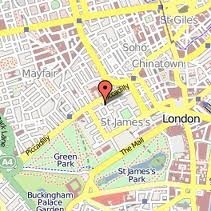 map of St. James
map of St. JamesSt. James is bordered on the east by Haymarket, on the north by Piccadilly, on the south by the Mall and St. James Park, and on the west by Green Park. Once part of the royal hunting grounds itself, like the Parks, the area of St. James was granted by Charles II to Henry Jermyn (Earl of St.Albans) to develop as a residential neighborhood adjacent to St. James Palace.
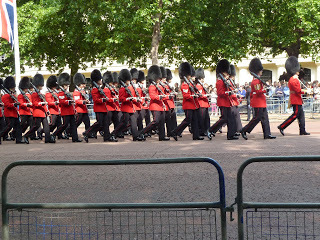
Last June (2011), I watched the Queen and Royal Family, accompanied by a FEW of her Guards, parade from Buckingham Palace along the Mall toward the parade ground at Horse Guards for the annual Trooping the Colour. See this blog of July 30, 2011, for more.
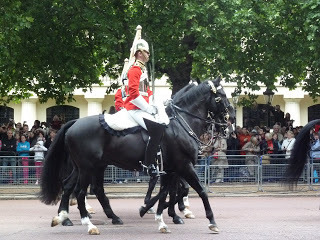
The Queen was accompanied by the Duke of Edinburgh, beside her and following were Prince Charles, Prince William, and Princess Anne on horseback.in their uniforms as Colonels of Guards regiments.
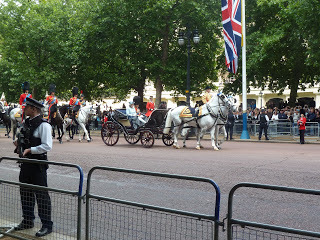
While the Queen was reviewing her troops, I took the opportunity to wander around St. James and snap more pictures. I walked up the steps from the Mall between the two large buildings that comprise Carlton House Terrace, once the site of the Prince Regent's fantastic Carlton House, demolished in 1825.
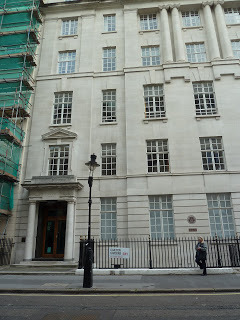
The large townhouses which comprise the Terrace wings and Carlton Gardens are mostly offices now but once housed distinguished figures such as Lord Palmerston.
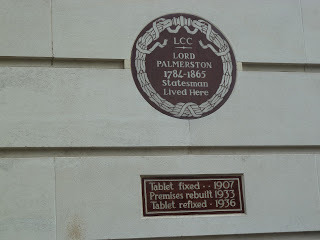
Waterloo Place is not much more than a parking lot, sadly.
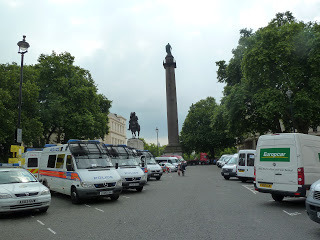 Waterloo Place with Duke of York Column
Waterloo Place with Duke of York ColumnThe large monument is to the Duke of York, son of George III and brother of George IV.
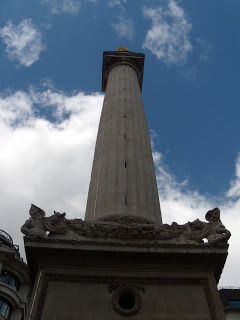
Waterloo Place was to be the terminal point of the great development of Regent Street, stretching from the Mall to Regent's Park, as designed by architect John Nash for George IV, and for which Carlton House itself was demolished. But unlike the nearby Trafalgar Square, it has never become a public gathering place of importance.
Looking in the other direction, north, up Regent Street.
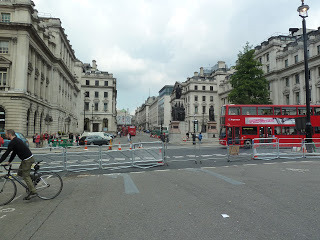
One one side of Waterloo Place is the Traveller's Club and on the other is the Athenaeum with its garden. I assume all the distinguished members were at Horse Guards, for it appeared to be rather deserted.
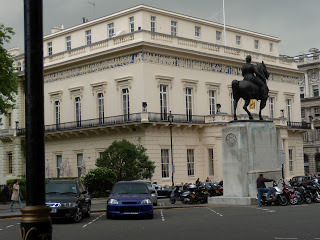 Atheneaum, with equestrian statue of Edward VII
Atheneaum, with equestrian statue of Edward VII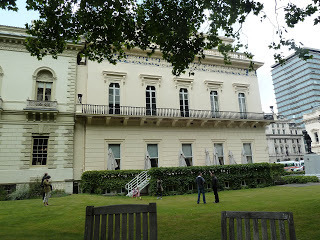 Athenaeum and Garden
Athenaeum and Garden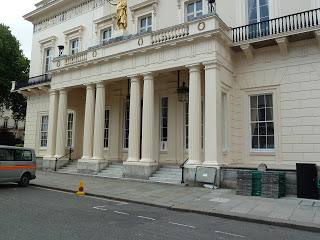 Athenaeum Entrance
Athenaeum EntranceThings were pretty quiet with everyone watching for the Queen's return, so I turned west and walked down Pall Mall.
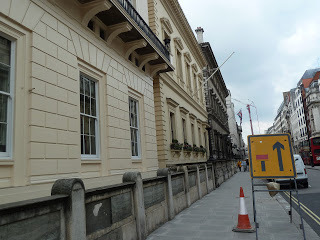 Above, looking west on Pall Mall with London's ever present traffic diversions
Above, looking west on Pall Mall with London's ever present traffic diversionsAt 87 Pall Mall is the elegant facade of Schomberg House with its Coade Stone figures supporting its portico.
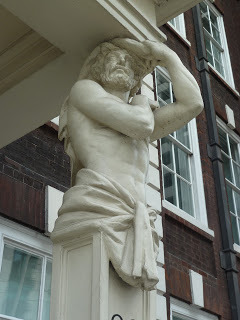
Just a few steps farther is the handsome 79 Pall Mall with its lovely window set off by pink geraniums looking out at the busy street.
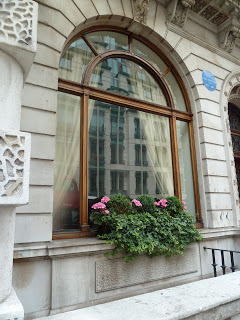
A building on this site, still part of the Crown Estate, was given to Nell Gwynne (1650-1687), the little orange seller who became the Restoration Theatre's most famous actress -- as well as being one of the mistresses of Charles II.
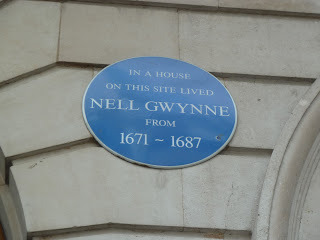
I'll continue with my St. James Views soon...next stop, Marlborough House and St. James Palace. How I long to return...there's so much more to explore in just this one small area of London.
Published on April 30, 2012 01:00
April 28, 2012
Another 'Look of Love"
Victoria here, having recently toured the exhibit "The Look of Love" at the Birmingham Museum of Art in Alabama (on my way home from a winter in Florida near Kristine and Jo).
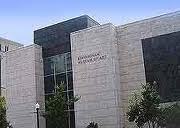
This was my first ever visit to Birmingham and thus my first taste of the delicious museum of art, which we began with luncheon at Oscar's Restaurant (delicious, indeed!) before approaching our target: The Look of Love: Eye: Miniatures from the Skier Collection.
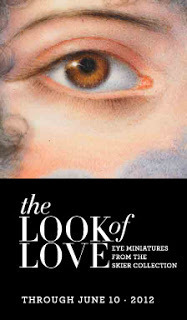
The museum was filled with children. probably school tours, and they seemed particularly attracted to the museum shop, like all kids everywhere, seeking a memento of their visit.
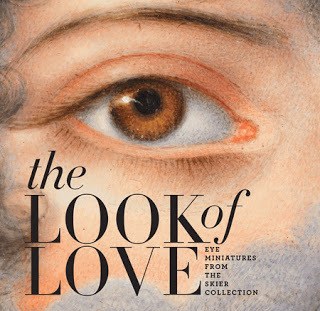
I had read about the exhibition on line in articles published all over (see Jo Manning's piece here), and in the catalogue, which absorbed my attention cover to cover. Even if you are not fortunate enough to make your way to Birmingham before June 10, this catalogue will give you an excellent view of all the pieces accompanied by several scholarly articles and Jo Manning's delightful fictional vignettes.
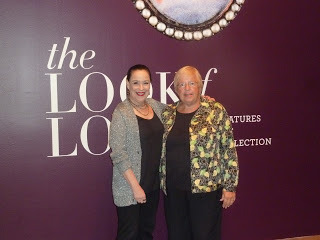 Nan Skier and Victoria at the exhibition
Nan Skier and Victoria at the exhibition
I was fortunate to be introduced on-line (by Jo Manning) to Nan Skier, and we met in person at the exhibition. We had an enlightening chat about the unique collection she and her husband, Dr. David Skier, have amassed. To hear her tell how they got started, listen to this interview via Skype with Polish television.
The very tiny objects, from as small as less than half a square inch to a wallet containing both a lover's eye and miniature of a hand, and a tea cup decorated with an eye, are exhibited in a darkened room in handsome cases and vitrines under pinpoints of light. Thus my pictures are both dark and a little blurry since they are enlarged quite a bit. The better pictures here are the official pictures by the professional photographer Sean Pathashema.
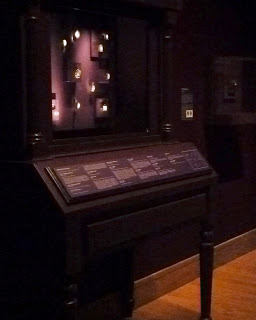
Above is one of the cases on which the Lover's Eyes are displayed with descriptions below. Though it might be hard to photograph, the layout is very effective in presenting the delicate objects in the best possible manner.
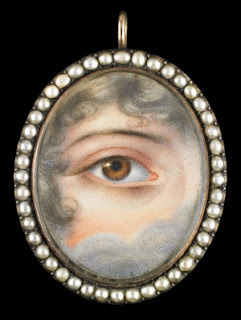 Gold oval pendant surrounded by seed pearls, ca. 1830. Brown right eye with clouds1 7/8 (with hanger) x 1 3/8 x 1/4 in.
Gold oval pendant surrounded by seed pearls, ca. 1830. Brown right eye with clouds1 7/8 (with hanger) x 1 3/8 x 1/4 in.
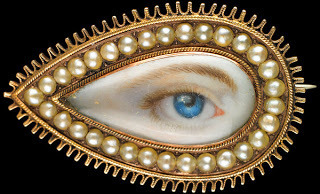 gold teardrop-shaped brooch surrounded by split pearls, ca. 1790; Blue right eye.
gold teardrop-shaped brooch surrounded by split pearls, ca. 1790; Blue right eye.
3/4 x 1 1/4 x 1/4 in.
The Lover's Eyes in the Skier Collection are all similar -- yet no two are alike. Most of them are worn as jewelry -- rings, pendants, bracelets, e.g.
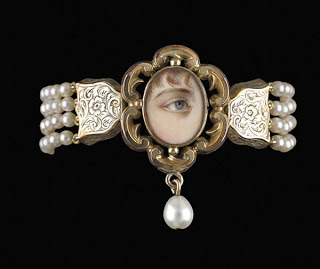 Bracelet surmounted with miniature in gold surround with drop pearl; Plaited hairwork on reverse; Restrung with four strands of cultured pearls; Gray right eye. 1 5/8 x 2 x 1/4 in. (surround only)
Bracelet surmounted with miniature in gold surround with drop pearl; Plaited hairwork on reverse; Restrung with four strands of cultured pearls; Gray right eye. 1 5/8 x 2 x 1/4 in. (surround only)
Many are set with precious stones: there are examples of pearls, diamonds, garnets, coral and turquoise, among others.
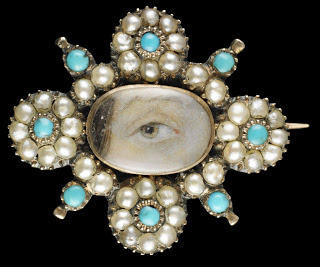 Yellow gold brooch with border of thirty-two natural oriental half pearls in a floral motif with eight small turquoise stones; oval locket back with woven brown hair under glass, c. 1820brown right eye; 1 x 1 1/8 x 1/4 in.
Yellow gold brooch with border of thirty-two natural oriental half pearls in a floral motif with eight small turquoise stones; oval locket back with woven brown hair under glass, c. 1820brown right eye; 1 x 1 1/8 x 1/4 in.
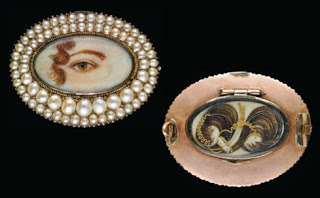 Rose gold oval brooch surrounded by double asymmetrical rows of seed pearls; suggestion of cloud border; convex backing with Prince of Wales hair plumes; brown right eye; 1 x 1 1/4 x 1/4 in.
Rose gold oval brooch surrounded by double asymmetrical rows of seed pearls; suggestion of cloud border; convex backing with Prince of Wales hair plumes; brown right eye; 1 x 1 1/4 x 1/4 in.
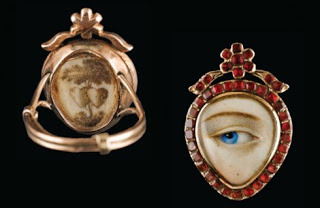 Heart shaped gold ring with Hessonite garnet surroundcrowned with a flower and ribbon motif, c. 1790. Blue right eye. on reverse of ivory lozenge is a sepia and embroidered hairwork image depicting interlocking hearts in front of an oak. 15/16 x 5/8 x 7/8 in.
Heart shaped gold ring with Hessonite garnet surroundcrowned with a flower and ribbon motif, c. 1790. Blue right eye. on reverse of ivory lozenge is a sepia and embroidered hairwork image depicting interlocking hearts in front of an oak. 15/16 x 5/8 x 7/8 in.
Every one of these objects must have a story -- of love or of loss. But few can be identified by either sitter or artist. History has made them unknown, and this gives a particularly poignant and mysterious twist to the exhibition. In a brilliant move, however, the catalogue contains several fictional stories -- what MIGHT have been. Jo Manning is the author and her imagination took wing. Highly recommended.
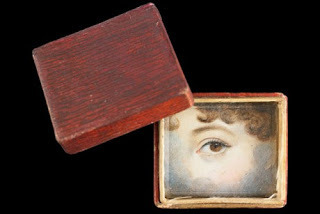 So-called "Memory Box" made of embossed and painted papercontaining eye miniature, c. 1830. Brown left eye.1 1/8 x 1 1/4 x 5/8 in.
So-called "Memory Box" made of embossed and painted papercontaining eye miniature, c. 1830. Brown left eye.1 1/8 x 1 1/4 x 5/8 in.
A patch box, a stick pin, the wallet, and the teacup -- what many uses have been fund for the lover's eyes. Nan and I discussed the fact that many of the eyes portrayed are from the left side, and we speculated on how such a choice could be made -- by the artist, the sitter or the person who made the commission?
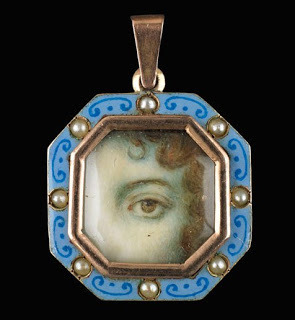 Rose gold pendant surrounded by blue enamel with half pearls. Brown left eye. 1 x 11/16 x 1.8 in.
Rose gold pendant surrounded by blue enamel with half pearls. Brown left eye. 1 x 11/16 x 1.8 in.
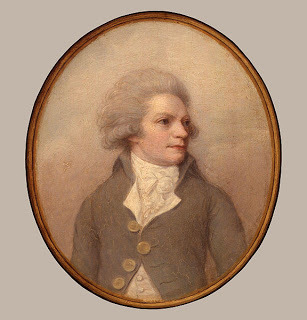 Richard Cosway, self-portrait (1742-1821) c. 1790National Portrait Gallery, London
Richard Cosway, self-portrait (1742-1821) c. 1790National Portrait Gallery, London
It amused me to note that one of the few lover's eyes that an be identified by its artist is by Richard Cosway (1742-1821) greatly celebrated in his day as a painter and a close friend of the Prince Regent, later George IV. And yet, this particular piece is one of very few that is not bejeweled, but instead decorated with paste (fake) red stones. Rather ironic, I thought.
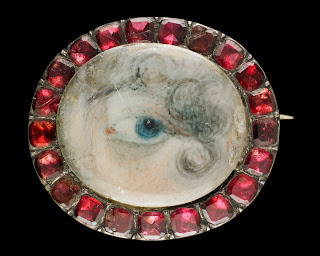 Gold oval brooch surrounded by foil-backed red pastes, c. 1790. Blue left eye surrounded by curlsAttributed to Richard Cosway
Gold oval brooch surrounded by foil-backed red pastes, c. 1790. Blue left eye surrounded by curlsAttributed to Richard Cosway
Many thanks to Nan Skier for gracious hospitality and fascinating discussion.
The Look of Love is a most interesting and beautiful exhibition. You have a month, until June 10, 2012, to make it to Birmingham. Hurry!
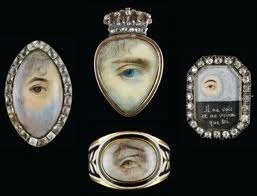
I will report on other treasures in the Birmingham Museum of Art shortly.


This was my first ever visit to Birmingham and thus my first taste of the delicious museum of art, which we began with luncheon at Oscar's Restaurant (delicious, indeed!) before approaching our target: The Look of Love: Eye: Miniatures from the Skier Collection.

The museum was filled with children. probably school tours, and they seemed particularly attracted to the museum shop, like all kids everywhere, seeking a memento of their visit.

I had read about the exhibition on line in articles published all over (see Jo Manning's piece here), and in the catalogue, which absorbed my attention cover to cover. Even if you are not fortunate enough to make your way to Birmingham before June 10, this catalogue will give you an excellent view of all the pieces accompanied by several scholarly articles and Jo Manning's delightful fictional vignettes.
 Nan Skier and Victoria at the exhibition
Nan Skier and Victoria at the exhibitionI was fortunate to be introduced on-line (by Jo Manning) to Nan Skier, and we met in person at the exhibition. We had an enlightening chat about the unique collection she and her husband, Dr. David Skier, have amassed. To hear her tell how they got started, listen to this interview via Skype with Polish television.
The very tiny objects, from as small as less than half a square inch to a wallet containing both a lover's eye and miniature of a hand, and a tea cup decorated with an eye, are exhibited in a darkened room in handsome cases and vitrines under pinpoints of light. Thus my pictures are both dark and a little blurry since they are enlarged quite a bit. The better pictures here are the official pictures by the professional photographer Sean Pathashema.

Above is one of the cases on which the Lover's Eyes are displayed with descriptions below. Though it might be hard to photograph, the layout is very effective in presenting the delicate objects in the best possible manner.
 Gold oval pendant surrounded by seed pearls, ca. 1830. Brown right eye with clouds1 7/8 (with hanger) x 1 3/8 x 1/4 in.
Gold oval pendant surrounded by seed pearls, ca. 1830. Brown right eye with clouds1 7/8 (with hanger) x 1 3/8 x 1/4 in. gold teardrop-shaped brooch surrounded by split pearls, ca. 1790; Blue right eye.
gold teardrop-shaped brooch surrounded by split pearls, ca. 1790; Blue right eye.3/4 x 1 1/4 x 1/4 in.
The Lover's Eyes in the Skier Collection are all similar -- yet no two are alike. Most of them are worn as jewelry -- rings, pendants, bracelets, e.g.
 Bracelet surmounted with miniature in gold surround with drop pearl; Plaited hairwork on reverse; Restrung with four strands of cultured pearls; Gray right eye. 1 5/8 x 2 x 1/4 in. (surround only)
Bracelet surmounted with miniature in gold surround with drop pearl; Plaited hairwork on reverse; Restrung with four strands of cultured pearls; Gray right eye. 1 5/8 x 2 x 1/4 in. (surround only)Many are set with precious stones: there are examples of pearls, diamonds, garnets, coral and turquoise, among others.
 Yellow gold brooch with border of thirty-two natural oriental half pearls in a floral motif with eight small turquoise stones; oval locket back with woven brown hair under glass, c. 1820brown right eye; 1 x 1 1/8 x 1/4 in.
Yellow gold brooch with border of thirty-two natural oriental half pearls in a floral motif with eight small turquoise stones; oval locket back with woven brown hair under glass, c. 1820brown right eye; 1 x 1 1/8 x 1/4 in. Rose gold oval brooch surrounded by double asymmetrical rows of seed pearls; suggestion of cloud border; convex backing with Prince of Wales hair plumes; brown right eye; 1 x 1 1/4 x 1/4 in.
Rose gold oval brooch surrounded by double asymmetrical rows of seed pearls; suggestion of cloud border; convex backing with Prince of Wales hair plumes; brown right eye; 1 x 1 1/4 x 1/4 in. Heart shaped gold ring with Hessonite garnet surroundcrowned with a flower and ribbon motif, c. 1790. Blue right eye. on reverse of ivory lozenge is a sepia and embroidered hairwork image depicting interlocking hearts in front of an oak. 15/16 x 5/8 x 7/8 in.
Heart shaped gold ring with Hessonite garnet surroundcrowned with a flower and ribbon motif, c. 1790. Blue right eye. on reverse of ivory lozenge is a sepia and embroidered hairwork image depicting interlocking hearts in front of an oak. 15/16 x 5/8 x 7/8 in.Every one of these objects must have a story -- of love or of loss. But few can be identified by either sitter or artist. History has made them unknown, and this gives a particularly poignant and mysterious twist to the exhibition. In a brilliant move, however, the catalogue contains several fictional stories -- what MIGHT have been. Jo Manning is the author and her imagination took wing. Highly recommended.
 So-called "Memory Box" made of embossed and painted papercontaining eye miniature, c. 1830. Brown left eye.1 1/8 x 1 1/4 x 5/8 in.
So-called "Memory Box" made of embossed and painted papercontaining eye miniature, c. 1830. Brown left eye.1 1/8 x 1 1/4 x 5/8 in.A patch box, a stick pin, the wallet, and the teacup -- what many uses have been fund for the lover's eyes. Nan and I discussed the fact that many of the eyes portrayed are from the left side, and we speculated on how such a choice could be made -- by the artist, the sitter or the person who made the commission?
 Rose gold pendant surrounded by blue enamel with half pearls. Brown left eye. 1 x 11/16 x 1.8 in.
Rose gold pendant surrounded by blue enamel with half pearls. Brown left eye. 1 x 11/16 x 1.8 in. Richard Cosway, self-portrait (1742-1821) c. 1790National Portrait Gallery, London
Richard Cosway, self-portrait (1742-1821) c. 1790National Portrait Gallery, LondonIt amused me to note that one of the few lover's eyes that an be identified by its artist is by Richard Cosway (1742-1821) greatly celebrated in his day as a painter and a close friend of the Prince Regent, later George IV. And yet, this particular piece is one of very few that is not bejeweled, but instead decorated with paste (fake) red stones. Rather ironic, I thought.
 Gold oval brooch surrounded by foil-backed red pastes, c. 1790. Blue left eye surrounded by curlsAttributed to Richard Cosway
Gold oval brooch surrounded by foil-backed red pastes, c. 1790. Blue left eye surrounded by curlsAttributed to Richard CoswayMany thanks to Nan Skier for gracious hospitality and fascinating discussion.
The Look of Love is a most interesting and beautiful exhibition. You have a month, until June 10, 2012, to make it to Birmingham. Hurry!

I will report on other treasures in the Birmingham Museum of Art shortly.
Published on April 28, 2012 01:00
April 26, 2012
Mycroft Holmes to the Rescue!
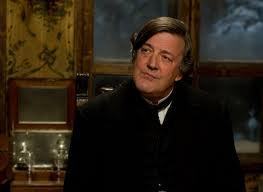

Little did Arthur Conan Doyle realize when he wrote his Sherlock Holmes novels that some time in the future, say in the early 21st century, it would be Sherlock's brother Mycroft who would step into the role of hero. Actually, two heroic roles, as there are two Mycroft Holmes coming to the rescue of the now derelict Undershaw, the Surrey home of Sir Arthur Conan-Doyle - Stephen Fry (above top), who plays Mycroft in the Robert Downey, Jr. big screen version of that story, and Mark Gatiss (above lower) who plays Mycroft in the BBC series Sherlock.
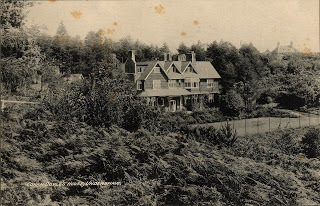
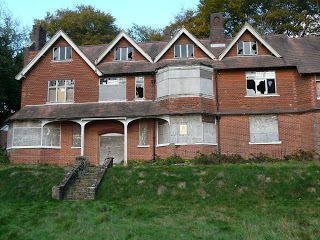
Undershaw, above in its heydey and as it stands today, is where Conan Doyle lived with his wife, Louise, from 1897 to 1907. Conan Doyle commissioned his house specially to take into account the prognosis for his wife Louise, who was suffering from TB and only expected to live a few months. In order to infuse the interiors with lots of healing natural light, Doyle instructed the architect to include oversized windows in his design.
It was whilst living at Undershaw that Conan Doyle became a Deputy Lieutenant of Surrey, and joined the local Chiddingfield Hunt and the golf club a from there that he entered the Boer War as a volunteer army surgeon. It was also at Undershaw that Conan Doyle wrote The Hound of the Baskervilles in 1902. Literary visitors to house during Conan Doyle's residency included Bram Stoker, the author of Dracula, who came to interview Conan Doyle, and Virginia Woolf. After 1907, when Conan Doyle sold the property, Undershaw fell into various hands until, from 1924 until 2004, the house was used as a hotel. Since then, the house has stood empty and remains boarded up in a half hearted attempted to save it from further vandalism.
Last year the local authority, Waverley Borough Council, stepped in to prevent the house being turned into 13 different "dwellings." At the time, it was owned by a company called Fossway. Christopher Atkins, from RDA Architects, speaking on their behalf, says: "It might have been his [Conan Doyle's] house once, but it has been through a number of different versions since. If it's left alone, it'll fall to pieces. The developer's intention is to provide a number of houses within the existing building and that will then provide the funding to enable it to be restored to its original position."
Oppostion against the scheme has been great and those working to turn the property into a Sherlock Holmes Museum include local MP and Culture Secretary Jeremy Hunt, Sir Christopher Frayling, Stephen Fry and UPT patron Mark Gatiss, who co-created the BBC series Sherlock and who plays Sherlock's brother Mycroft in that series. Together, they have formed the Undershaw Preservation Trust.
Stephen Fry has been vocal in his beliefs - the actor, writer, television presenter and film director, who has contributed to three documentaries on Conan Doyle and his character Sherlock Holmes, is a patron of the Conan Doyle library and was once the youngest member of the Sherlock Holmes Society of London.
“There has never been a time when Conan Doyle has gone out of fashion, or interest in him, his ideas and his creations has dropped off the radar,” said Fry. “But there has certainly never been a time when he has been more keenly appreciated and valued than now. . . . As an admirer of Doyle and his achievements, I urge Waverley Borough Council to reconsider what future ages will adjudge [to be] a foolish, short-sighted and wanton act of vandalism. . . . There is real value in Undershaw. If it is thought about, it can attract new generations of tourists to the area, it can be an enormous source of local pride. Please, please, have another think.”
As well, the Victorian Society, which has long been pushing for the Grade II-listed house to be given greater protective status from English Heritage, is also fighting to preserve Undershaw. "We are pushing for Grade I-listing," says spokeswoman Heloise Brown. "English Heritage originally turned it down on the grounds that Conan Doyle wasn't on quite the same level as other authors such as Jane Austen or Elizabeth Gaskell. Our argument is that Sherlock Holmes has such immense and universal appeal - there are 400 appreciation societies around the world - that the house really deserves extra protection."
Visit the Save Undershaw website for further information. You can also visit the Help to Save Undershaw blog here.[image error]
Published on April 26, 2012 00:02
April 24, 2012
How to Throw a Diamond Jubilee Party
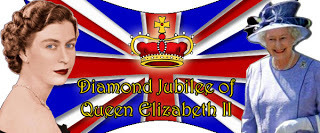
(Click on photos to go to retailer's websites)
Even the most non-domestic host can throw a good Jubilee party as long as they employ some slight of hand and a bit of dazzle. Below, we offer suggestions that might ensure that your guests won't notice that a few corners have been cut. Every good party begins with the invitations and we think these are a hoot -
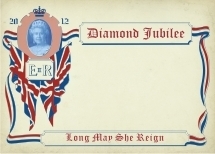
Once your invitations have been addressed (think Hyacinth Bucket) and posted, you may want to break out your Jubilee tea towel before beginning party day preparations. In any case, holding the tea towel when guests arrive will serve to give the impression that you've been making some sort of effort on their behalf, however marginal.
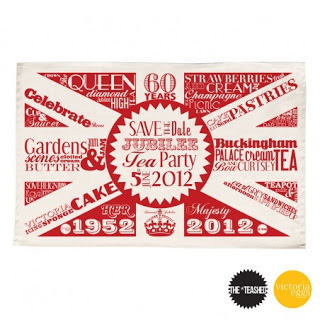
Now, first things first - the cocktails, complete with rim decorations from John Lewis -

(Note: If you distract them with these rim flags, your guests may not realize they're drinking Tesco's champers). Right, now that we've got the drinks sorted, you'll want to hang some bunting
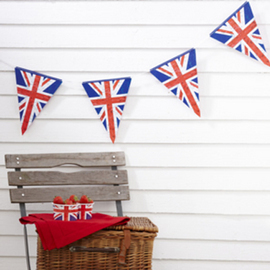
And inflate some balloons
 Don't forget to hand round the royal flags to be enthusiastically waved by guests
Don't forget to hand round the royal flags to be enthusiastically waved by guests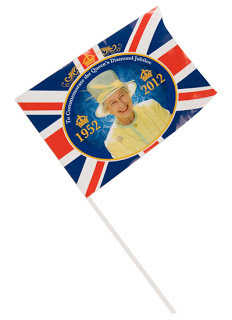
You may perhaps also wish to hand round a few Jubilee hats
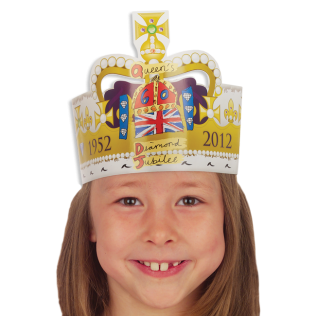
Or perhaps not . . . . but do have some door curtains handy for guests to walk through. Nothing says "party" like getting one's hair caught up in bits of string and tatty paper Union Jacks.

Once you've seen to it that your guests have been suitably lubricated and tousseled, they'll no doubt want to be fed. The expectation of a nosh or nibble is not, after all, unreasonable.
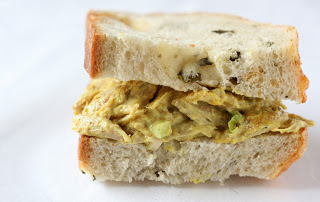
If a full on, Gordon Ramsay-like spread is beyond your capabilities, we suggest that you serve Coronation chicken sandwiches. Nothing could be easier. You'll find the quick "cheat" version of the recipe here. Afterwards, dazzle your guests by serving up some Fairy cakes (cupcakes) you'll have baked using the brilliant kit below

Simply use a boxed cake mix, some store bought icing and make up for it all by serving your Fairy cakes on these royal cake stands
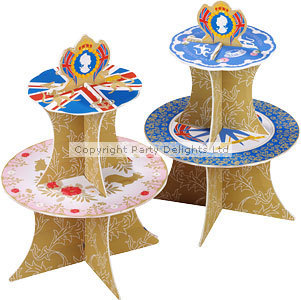
Whatever you do, don't forget to have Her Majesty on hand in order to thank your guests for coming as they leave
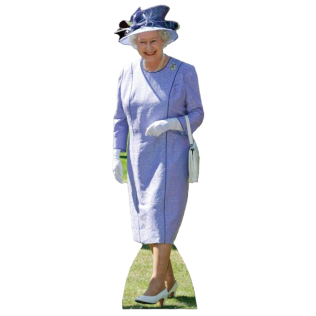
With any luck, they will have drank themselves silly and be on such a sugar high from all those Fairy cakes that they may not realize they're speaking to a cardboard cut-out. [image error]
Published on April 24, 2012 00:23
April 22, 2012
The Town Crier
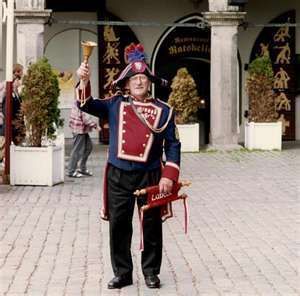
Town Criers have been a mainstay of English towns since the Medieval period, at least. Employed by the town or city, town criers dispensed various and sundry news and proclamations to the citizens, most of whom were illiterate and so depended upon verbal receipt of the news. This much I knew, though I don't suppose I gave the position of Town Crier a second thought, assuming that they didn't do much beyond walk about a town crying "all's well" upon the hour. However, I was recently reading The Life of Frances Power Cobb as Told By Herself, (1904), who was born in Dublin in 1822, and came upon the following passage: "Two years later, when I was seven years old, I was naughty enough to run away again, this time in the streets of Bath, in company with a hoop, and the Town Crier was engaged to "cry" me, but I found my way home at last alone."
.AOLWebSuite .AOLPicturesFullSizeLink { height: 1px; width: 1px; overflow: hidden; } .AOLWebSuite a {color:blue; text-decoration: underline; cursor: pointer} .AOLWebSuite a.hsSig {cursor: default}
Intrigued, I found the following excerpt from An Old Town By The Sea by Thomas Bailey Aldrich (1894) which was written of the town of Boston, but one assumes that town criers were of a similar description both sides of the Pond:
"The last of the cocked hats had gone out, and the railway had come in, long before my time; but certain bits of color, certain half obsolete customs and scraps of the past, were still left over. I was not too late, for example, to catch the last town crier — one Nicholas Newman, whom I used to contemplate with awe, and now recall with a sort of affection. Nicholas Newman — Nicholas was a sobriquet, his real name being Edward — was a most estimable person, very short, crosseyed, somewhat bow-legged, and with a bell out of all proportion to his stature. I have never since seen a bell of that size disconnected with a church steeple. The only thing about him that matched the instrument of his office was his voice. His "Hear All!" still deafens memory's ear. I remember that he had a queer way of sidling up to one, as if nature in shaping him had originally intended a crab, but thought better of it, and made a town-crier. Of the crustacean intention only a moist thumb remained, which served Mr. Newman in good stead in the delivery of the Boston evening papers, for he was incidentally newsdealer. His authentic duties were to cry auctions, funerals, mislaid children, traveling theatricals, public meetings, and articles' lost or found. He was especially strong in announcing the loss of reticules, usually the property of elderly maiden ladies. The unction with which he detailed the several contents, when fully confided to him, would have seemed satirical in another person, but on his part was pure conscientiousness. He would not let so much as a thimble, or a piece of wax, or a portable tooth, or any amiable vanity in the way of tonsorial device, escape him. I have heard Mr. Newman spoken of as "that horrid man." He was a picturesque figure. Possibly it is because of his bell that I connect the town crier with those dolorous sounds which I used to hear rolling out of the steeple of the Old North every night at nine o'clock — the vocal remains of the colonial curfew."
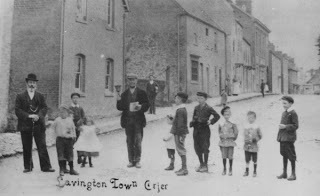
And from Printer's Ink,Volume 28-29 (1899)
"In former days, when local papers were few and far between, the town crier was an important personage. He was appointed by the pariah, and his election generally carried with it offices of beadle, verger and gravedigger, and his emoluments were fairly remunerative. Day after day he was seen, either in the town or surrounding villages, dressed as a parish beadle, and carrying a bell, which, after ringing twice or three times, he began: "Oh, yez. This is to give public notice that Master George will sell by public auction at the Town Hall, by order, the household furniture and other effects." Then followed details, and the windup, "God save the Queen."
"As a gossip of the first water, and knowing the goings on and little town scandals, he was a welcome guest everywhere when on his rounds, and there was no local public function, church, chapel, election or any other meeting but what he bad a finger in. When the newspaper stamp duty was abolished, and the local press sprang into existence in all directions, the town crier was gradually elbowed out until he became practically extinct.
"In one place, however, the town crier in all his glory is yet in evidence, and that is in the pretty town of Bedford. Mr. Stock, a well-known local advertising agent and billposter of portly and handsome presence, may be seen, dressed in a grandly laced scarlet coat, knee breeches and cocked hat to match. The old gentleman ambles about the town daily on his rounds, an object of curiosity to visitors and awe to the town boys. Long may he flourish as a survival of the good old custom!"
Surpisingly, further research uncovered the fact that the office of Town Crier is alive and well, on both sides of the pond. As Wikipedia informs us: "Many local councils in England and Wales reinstated the post of town crier from the mid 1990s onwards (e.g. Chester). Many are honorary appointments or employed part time by the council. As of October 2010, there were 144 towns in England and Wales with town criers registered with the Ancient and Honourable Guild of Town Criers. They mainly perform ceremonial duties at civic functions. Local councils with a paid town crier often make them available for charity events.
"There are several town crier guilds in both Canada and the United States. Theses include the Ontario Guild of Town Criers, the Nova Scotia Criers' Guild and the American Guild of Town Criers. Since 1981, The Rocky Mountain Town Crier, presently based out of Calgary, Alberta, Canada, has represented Invermere, British Columbia at Buckingham Palace & the Mansion House & the House of Commons in London England. Nelson Phillips, the Rocky Mountain Town Crier has been Proclaimed the Honourary Town Crier of Banff, Scotland, Calgary, Scotland, & Airdrie, Scotland. He visited these 3 locations and read Proclamations from the Mayors or Government Officials, of the communities with the same name . . . . In competition, Nelson has placed 2nd at Lytham St. Anne, for best shout and 3rd at Kingsbridge Devon, for best dressed. On November 7, 1984, The Rocky Mountain Town Crier was made a member of Calgary's "Walkway of Fame" when he read Proclamations from Her Majesty Queen Elizabeth II, Prime Minister Brian Mulroney & Mayor Ralph Klein acknowledging the 100 Anniversary of Calgary Alberta as a Town. Nelson's footprints and Hand prints were placed in cement."[image error]
Published on April 22, 2012 00:22
April 19, 2012
A Letter From King Leopold
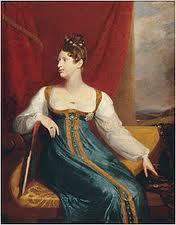
From: The Letters of Queen Victoria by John Murray
The King of the Belgians to Queen Victoria. Laeken, 21st May 1845.
My Dearest And Most Beloved Victoria,— Receive my sincerest and most heartfelt good wishes on the happy reappearance of your birthday. I need not dwell on my sentiments of devotion to you; they began with your life, and will only end with mine. The only claim I make is to be remembered with some little affection. Thank heaven, I have little to wish you, than that your present happiness may not be disturbed, and that those who are dear to you may be preserved for your happiness.My gift is Charlotte's portrait. The face is extremely like, and the likest that exists; the hair is a little too fair, it had become also darker. I take this opportunity to repeat that Charlotte was a noble-minded and highly gifted creature. She was nervous, as all the family have been; she could be violent, but then she was full of repentance for it, and her disposition highly generous and susceptible of great devotion. I am the more bound to say this, as I understood that you had some notion that she had been very imperious, and not mistress of her temper. Before her marriage some people by dint of flattery had tried to give her masculine tastes; and in short had pushed her to become one day a sort of Queen Elizabeth. These sentiments were already a little modified before her marriage. But she was particularly determined to be a good and obedient wife; some of her friends were anxious she should not; amongst these Madame de Flahaut must be mentioned en premiere ligne.
This became even a subject which severed the intimacy between them. Madame de Flahaut, much older than Charlotte, and of a sour and determined character, had gained an influence which partook on Charlotte's part a little of fear. She was afraid of her, but when once supported took courage.People were much struck on the 2nd of May 1816 at Carlton House with the clearness and firmness with which she pronounced "and obey" etc., as there had been a general belief that it would be for the husband to give these promises. The Regent put me particularly on my guard, and said, " If you don't resist she will govern you with a high hand." Your own experience has convinced you that real affection changes many sentiments that may have been implanted into the mind of a young girl. With Charlotte it was the more meritorious, as from a very early period of her life she was considered as the heiress of the Crown; the Whigs flattered her extremely, and later, when she got by my intervention reconciled to the Tories, they also made great efforts to please her.Her understanding was extremely good; she knew everybody, and I even afterwards found her judgment generally extremely correct. She had read a great deal and knew well what she had read. Generous she was almost too much, and her devotion was quite affecting, from a character so much pushed to be selfish and imperious.I will here end my souvenir of poor dear Charlotte, but I thought that the subject could not but be interesting to you. Her constancy in wishing to marry me, which she maintained under difficulties of every description, has been the foundation of all that touched the family afterwards. You know, I believe, that your poor father was the chief promoter, though also the Yorks were; but our correspondence from 1814 till 1816 was entirely carried on through his kind intervention; it would otherwise have been impossible, as she was really treated as a sort of prisoner. Grant always to that good and generous Charlotte, who sleeps already with her beautiful little boy so long, where all will go to, an affectionate remembrance, and believe me she deserves it.Forgive my long letter, and see in it, what it really is, a token of the great affection I have for you. Ever, my dearest Victoria, your devoted Uncle,Leopold R.
Published on April 19, 2012 23:50
April 17, 2012
Court and Fashionable Life
From The Court Journal, Volume 7, 1835
Court and Fashionable Life
The Duke of Cumberland is expected in town in a few days, from his residence near Berlin. The statement that some of the luggage, and of the domestic establishment, of his Royal Highness arrived in town on Wednesday is incorrect.
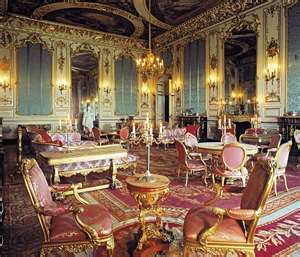
Interior, Belvoir Castle
— The Duke of Wellington after celebrating the birth-day of his old friend, the Earl of Westmoreland at Apthorpe, will join the festivity at Belvoir Castle on Monday, where the natal day of the Duke of Rutland will be commemorated with distinguished honours by a large tenantry, in addition to the visitors from London.— The Right Hon. J. C. Herries left town yesterday for Hardwick to attend his Election. Lord Granville Somerset, Sir Henry Hardinge, and Mr Ross, have also left town to attend their Elections.— Lord Rosslyn has removed from Chapel street to a house in Grosvenor place.— Lord Haddington is expected to leave town this day for Ireland, to enter on the responsible duties of his high office as Lord Lieutenant. Sir Henry Hardinge, Secretary for Ireland, is not expected to go to Ireland till after his Election.— The Brazilian Minister will leave town in the course of a few days for Lisbon, to pay a complimentary visit to the Queen of Portugal on her recent marriage.— The Commissioners for the Reduction of the National Debt held a Meeting yesterday at the Treasury. Sir Robert Feel was present, as Chancellor of the Exchequer. The Governor and Deputy-Governor of the Bank also attended.— The Marquess and Marchioness of Wellesley, since his Lordship's return from the Government of Ireland, have been staying at the Clarendon, where they will remain until they can procure a town residence. The Marchioness will, in a few days, resume her duties at the Court at Brighton, as one of the Ladies in Waiting on the Queen.— The Earl of Eldon has been for some time on a visit to his venerable brother, Lord Stowell, at his seat, Early Court, in Berkshire. The mansion of the Noble Earl, in Hamilton place, Piccadilly, has been recently adorned and beautified, preparatory to his Lordship's return, which is expected in a few days. Lord Stowell's health and strength, we regret to state, continue to decline.
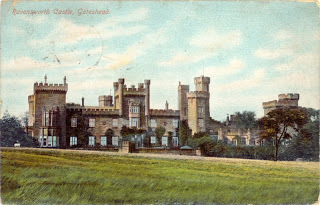
Ravensworth Castle
— The Countess of Mulgrave has been paying a lengthened visit to her father, at Ravensworth Castle, in the county of Durham. From thence she returned to join Lord Mulgrave at the Clajrendon Hotel, in Bond street. The Earl and Countess are now at Brighton, where, with their family, they will remain for a short period.— The Right Hon. Henry Ellis is preparing to leave England on a special mission to Persia. His suite will include Mr Sheridan, as private Secretary, brother of the accomplished Mrs Norton, and son of the late Mr Thomas Sheridan.— The Dowager Marchioness of Salisbury recently gave a magnificent banquet at her house, in Arlington street, to more than twenty distinguished personages, among whom were the Duke of Wellington, Lord and Lady Maryborough, Lord Cowley, the Earl and Countess of Jersey, and Sir John and Lady Anne Beckett. The Dowager Marchioness is now at Hatfield participating the festivities of Christmas, which are annually sustained there by the Marquess and Marchioness of Salisbury, in great splendour.— The Marquess of Hertford and his numerous suite intend to return to London, from Naples, early in the spring. It is reported that a high diplomatic situation has been offered to the Noble Marquess by his friend Sir Robert Peel.
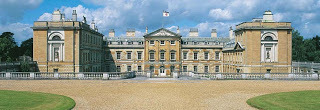
Woburn Abbey
— The festivities at Woburn Abbey have been splendidly sustained during the Christmas holidays. The Duchess of Bedford, the presiding star, has congregated around her all the leading nobility of the county of Bedford, in addition to her numerous relations, including Lady Gcorgiana Russell, and the Marquess and Marchioness of Tavistock and their children.— The Earl and Countess of Albemarle are returned to the Stud House, at Hampton Court, from Paris, where those distinguished persons were called, in consequence of the death of their near relation, Sir William Keppcl, who has left the bulk of his fortune to the Noble Earl. It is doubtful if the Duke of Dorset, the successor of Lord Albemarle as Master of the Horse, will remove to the Stud House, notwithstanding it has for some years been the official residence.— The Earl Fitzwilliam and his delightful family have left Wentworth House, in Yorkshire, for another of his Lordship's seats, Milton, in Northamptonshire, where they intend to remain until the meeting of Parliament.— The Duke of Rutland is now at Belvoir Castle superintending preparations for a grand banquet, to be given at that princely residence, on Monday, in honour of the Noble Duke's birth-day. The Earl and Countess of Lonsdale are expected there from Cottesmore, and the Marquess and Marchioness of Exeter from Burleigh. The Duke of Wellington will likewise be present. Lord Forester, Sir F. Trench, General Upton, and the Hon. William Howard, are already arrived at the Castle. There will be a splendid ball and supper in the evening, to which all the rank and fashion of the county of Rutland are invited.— Hatfield House festivities were this year deprived of the presence of the Duke of Wellington in consequence of various important engagements at the Foreign Office. The Earl of Aberdeen, Lord Rosslyn, the Dowager Marchioness of Salisbury, and many distinguished foreigners, constituted a portion of the noble guests that were invited.— The "Princely Palace" of Alnwick Castle greeted the return of the Duke of Northumberland from the South, who was accompanied by his only brother, Lord Prudhoe, with warm and affectionate rejoicing. The amiable Duchess and her distinguished visitors have been sustaining "old English hospitality" in a style worthy the House of Percy, and commensurate with the large and princely fortune of its noble owner. The Duke and Duchess of Northumberland are expected in London, about the period that the Duchess of Kent and the Princess Victoria return from St Leonard's.— The Marquess and Marchioness of Londonderry and family are passing the Christmas holidays, at Stockton-on-Tees, with much festivity. The noble Marquess is expected in town early next month, preparatory to making arrangements for his departure for St Petersburgh, as Ambassador to the Russian Court.
Court and Fashionable Life
The Duke of Cumberland is expected in town in a few days, from his residence near Berlin. The statement that some of the luggage, and of the domestic establishment, of his Royal Highness arrived in town on Wednesday is incorrect.

Interior, Belvoir Castle
— The Duke of Wellington after celebrating the birth-day of his old friend, the Earl of Westmoreland at Apthorpe, will join the festivity at Belvoir Castle on Monday, where the natal day of the Duke of Rutland will be commemorated with distinguished honours by a large tenantry, in addition to the visitors from London.— The Right Hon. J. C. Herries left town yesterday for Hardwick to attend his Election. Lord Granville Somerset, Sir Henry Hardinge, and Mr Ross, have also left town to attend their Elections.— Lord Rosslyn has removed from Chapel street to a house in Grosvenor place.— Lord Haddington is expected to leave town this day for Ireland, to enter on the responsible duties of his high office as Lord Lieutenant. Sir Henry Hardinge, Secretary for Ireland, is not expected to go to Ireland till after his Election.— The Brazilian Minister will leave town in the course of a few days for Lisbon, to pay a complimentary visit to the Queen of Portugal on her recent marriage.— The Commissioners for the Reduction of the National Debt held a Meeting yesterday at the Treasury. Sir Robert Feel was present, as Chancellor of the Exchequer. The Governor and Deputy-Governor of the Bank also attended.— The Marquess and Marchioness of Wellesley, since his Lordship's return from the Government of Ireland, have been staying at the Clarendon, where they will remain until they can procure a town residence. The Marchioness will, in a few days, resume her duties at the Court at Brighton, as one of the Ladies in Waiting on the Queen.— The Earl of Eldon has been for some time on a visit to his venerable brother, Lord Stowell, at his seat, Early Court, in Berkshire. The mansion of the Noble Earl, in Hamilton place, Piccadilly, has been recently adorned and beautified, preparatory to his Lordship's return, which is expected in a few days. Lord Stowell's health and strength, we regret to state, continue to decline.

Ravensworth Castle
— The Countess of Mulgrave has been paying a lengthened visit to her father, at Ravensworth Castle, in the county of Durham. From thence she returned to join Lord Mulgrave at the Clajrendon Hotel, in Bond street. The Earl and Countess are now at Brighton, where, with their family, they will remain for a short period.— The Right Hon. Henry Ellis is preparing to leave England on a special mission to Persia. His suite will include Mr Sheridan, as private Secretary, brother of the accomplished Mrs Norton, and son of the late Mr Thomas Sheridan.— The Dowager Marchioness of Salisbury recently gave a magnificent banquet at her house, in Arlington street, to more than twenty distinguished personages, among whom were the Duke of Wellington, Lord and Lady Maryborough, Lord Cowley, the Earl and Countess of Jersey, and Sir John and Lady Anne Beckett. The Dowager Marchioness is now at Hatfield participating the festivities of Christmas, which are annually sustained there by the Marquess and Marchioness of Salisbury, in great splendour.— The Marquess of Hertford and his numerous suite intend to return to London, from Naples, early in the spring. It is reported that a high diplomatic situation has been offered to the Noble Marquess by his friend Sir Robert Peel.

Woburn Abbey
— The festivities at Woburn Abbey have been splendidly sustained during the Christmas holidays. The Duchess of Bedford, the presiding star, has congregated around her all the leading nobility of the county of Bedford, in addition to her numerous relations, including Lady Gcorgiana Russell, and the Marquess and Marchioness of Tavistock and their children.— The Earl and Countess of Albemarle are returned to the Stud House, at Hampton Court, from Paris, where those distinguished persons were called, in consequence of the death of their near relation, Sir William Keppcl, who has left the bulk of his fortune to the Noble Earl. It is doubtful if the Duke of Dorset, the successor of Lord Albemarle as Master of the Horse, will remove to the Stud House, notwithstanding it has for some years been the official residence.— The Earl Fitzwilliam and his delightful family have left Wentworth House, in Yorkshire, for another of his Lordship's seats, Milton, in Northamptonshire, where they intend to remain until the meeting of Parliament.— The Duke of Rutland is now at Belvoir Castle superintending preparations for a grand banquet, to be given at that princely residence, on Monday, in honour of the Noble Duke's birth-day. The Earl and Countess of Lonsdale are expected there from Cottesmore, and the Marquess and Marchioness of Exeter from Burleigh. The Duke of Wellington will likewise be present. Lord Forester, Sir F. Trench, General Upton, and the Hon. William Howard, are already arrived at the Castle. There will be a splendid ball and supper in the evening, to which all the rank and fashion of the county of Rutland are invited.— Hatfield House festivities were this year deprived of the presence of the Duke of Wellington in consequence of various important engagements at the Foreign Office. The Earl of Aberdeen, Lord Rosslyn, the Dowager Marchioness of Salisbury, and many distinguished foreigners, constituted a portion of the noble guests that were invited.— The "Princely Palace" of Alnwick Castle greeted the return of the Duke of Northumberland from the South, who was accompanied by his only brother, Lord Prudhoe, with warm and affectionate rejoicing. The amiable Duchess and her distinguished visitors have been sustaining "old English hospitality" in a style worthy the House of Percy, and commensurate with the large and princely fortune of its noble owner. The Duke and Duchess of Northumberland are expected in London, about the period that the Duchess of Kent and the Princess Victoria return from St Leonard's.— The Marquess and Marchioness of Londonderry and family are passing the Christmas holidays, at Stockton-on-Tees, with much festivity. The noble Marquess is expected in town early next month, preparatory to making arrangements for his departure for St Petersburgh, as Ambassador to the Russian Court.
Published on April 17, 2012 00:48
Kristine Hughes's Blog
- Kristine Hughes's profile
- 6 followers
Kristine Hughes isn't a Goodreads Author
(yet),
but they
do have a blog,
so here are some recent posts imported from
their feed.


